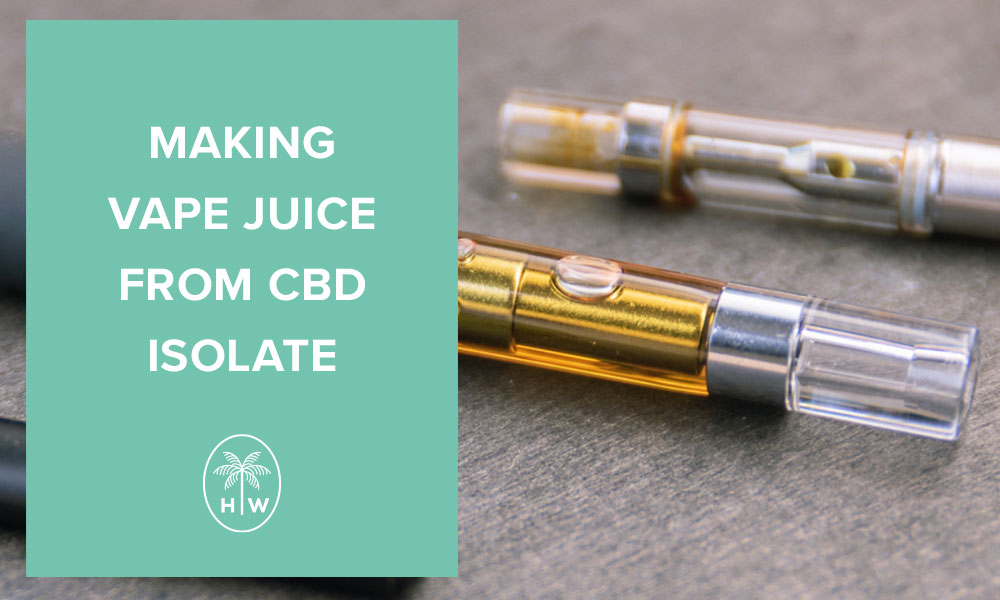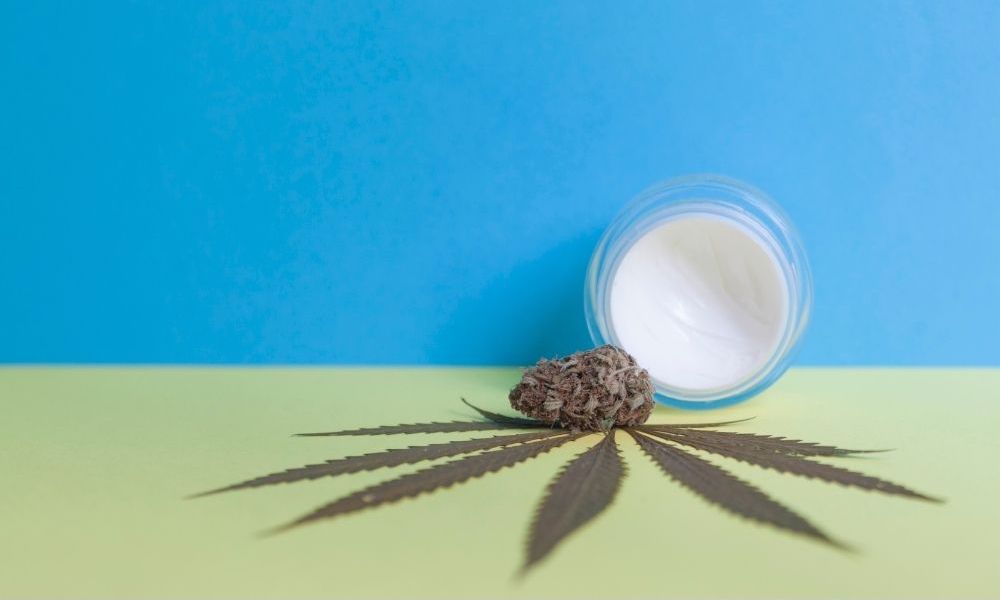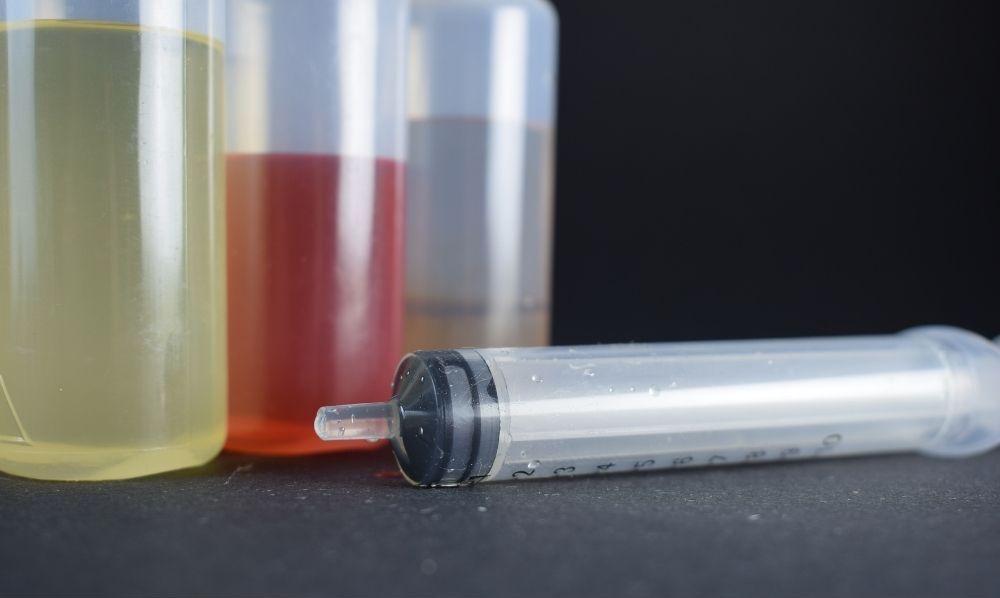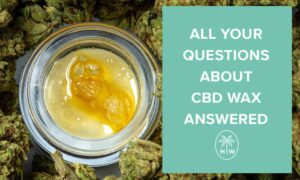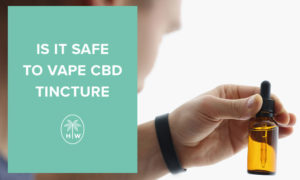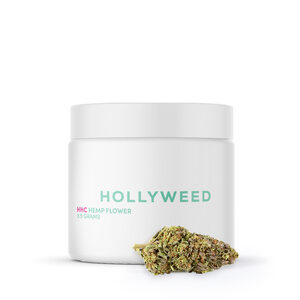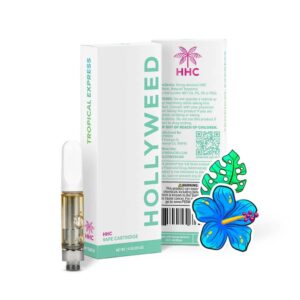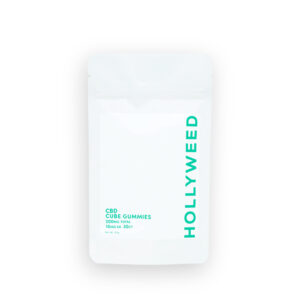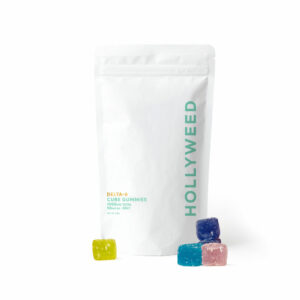Vapes are a portable and simple way to enjoy the effects of cannabidiol (CBD). Many people think of nicotine when they hear the word vape juice, but there are plenty of CBD options that contain no nicotine at all. If you’re up for a little DIY, we’re here to show you how to make vape juice from CBD isolate.
If you’re not sure what vape juice or CBD isolate is, no problem! We’ll take a look at each of these CBD forms and how they work with each other. Making your own vape liquid gives you control over the potency and flavor of your vaping experience, so let’s find out how!
Table of Contents
What is Vape Juice Made Of?
Vape juice is typically made by combining a carrier oil with flavorings. Carrier oils like propylene glycol (PG), vegetable glycerin (VG), or medium-chain triglycerides (MCT) help dilute potent compounds and “carry” them into the body. Flavor enhances the vaping experience.
Carrier oils and flavors are the foundation for most vape juice (also called e-juice or e-liquid) products. Other ingredients — like nicotine or CBD — can also be added. CBD e-juice may also use terpenes to enhance the natural flavors of the product.
Terpenes are compounds that give a plant its distinct taste and aroma. Manufacturers remove terpenes from cannabis in the same process they extract CBD. Terpenes are a great way to experience the organic flavor of CBD without using synthetic ingredients.
Not all e-liquids contain the same carrier oils, and each carrier has its own advantages. Here are some details of each carrier oil:
- Vegetable glycerin – This is a popular choice because it is smooth, made from plant oils, and carries a hint of sweetness. It is also gentle on the throat, so the vapors won’t feel harsh or irritating when you inhale.
- Propylene glycol – You can mix this carrier with vegetable glycerin or use it separately. PG is often used to extend the shelf life of vape juice, but it can cause irritation or inflammation in some. These are not the same as allergic reactions, which are rare with propylene glycol use but still possible.
- MCT oil – This carrier is usually derived from coconuts, though palm kernels are another common source. Odorless and flavorless, MCT oil often adopts whatever other flavors are present in the e-liquid. Medium-chain triglyceride oil is made using a process called fractionation.
What Is CBD Isolate?
CBD isolates consist of over 99% pure cannabidiol. There are no other cannabinoids or terpenes present in isolate — just CBD only. Isolates can come in powder or crystal form, and both are very versatile. You can mix it into foods or beverages, let it dissolve under your tongue, or make vape juice with it!
CBD extracts are split into three categories: full spectrum, broad spectrum, and isolate. Each type has its own benefits, so be sure to experiment until you find the one for you.
Full spectrum CBD contains trace amounts of tetrahydrocannabinol (THC), which is a cannabinoid like CBD. THC and CBD’s primary difference is that tetrahydrocannabinol induces a euphoric “high,” while cannabidiol results in no intoxication, grogginess, or high. Trace amounts of THC can boost CBD’s effects, though the levels must not exceed 0.3%.
Broad spectrum products contain nearly all the compounds derived from hemp, except they leave out the THC. This type of extract is ideal for consumers who like to avoid THC altogether for drug testing or personal reasons.
As we mentioned before, isolates are only concerned with cannabidiol molecules. To make isolate, manufacturers refine CBD extract until it is a fine white powder. This powder is odorless, flavorless, and consists of nearly pure CBD.
The best CBD isolate comes from Hollyweed. We extract our CBD from cannabis plants grown in the United States, and all of our products comply with standards set by the Food and Drug Administration (FDA). This ensures that the crops are grown safely and do not contain more than 0.3% THC.
Can You Put CBD Oil in a Vape?
If you’re wondering whether you can vape CBD tincture, the answer is no! Please do not put your CBD oil in a vape device! Unfortunately, some manufacturers use the terms juice, e-liquid, and oil interchangeably. While juice and liquid are synonymous when it comes to vaping, you should avoid any company that brands their cartridges as “CBD vape oil.” Let’s find out why.
In a nutshell, CBD oil (also called tincture) is NOT meant to be inhaled. Dropped under the tongue? Yes. Swallowed? Sure! While CBD oil absorbs well in our digestive tract and mouth, it does not fare so well in our lungs. Vaping oil repeatedly can cause it to accumulate along the lungs’ surface.
This build-up can attract and breed bacteria, leading to a potentially fatal condition called lipoid pneumonia. The symptoms of lipid pneumonia include coughing, fever, and shortness of breath. Lipoid pneumonia is caused by inhaling oil, so be sure to check the label of your vape juice container and ensure you’re using the correct product.
How do CBD oil and vape juice cause such different effects when inhaled? It’s all about the carrier oils, which can be intended for digestion or inhalation. You should not eat a carrier oil designed for vaping or inhale an edible oil meant for oral consumption.
Now, if a product is branded as “CBD vape oil,” the manufacturer is likely not trying to give you lipoid pneumonia. Rather, they are probably out of touch with the modern CBD market, using outdated terminology. Calling e-liquid “CBD vape oil” is a sure sign of a poor-quality product.
Is CBD Vape Juice & CBD Oil the Same?
No, CBD vape juice and CBD oil are two entirely different products. CBD oil is meant for oral or topical consumption, while vape juice is supposed to be inhaled.
CBD tincture is often made with coconut or hemp seed oil, which is digestible and healthy for humans to consume. However, our lungs are not meant to handle the fats that are inside these food-grade carrier oils. You may then wonder why MCT oil is safe to vape if it is made from coconut oil.
MCT is made from fractionated coconut oil, which has been heated beyond its melting point to separate the fatty acids from the rest of the liquid. This process removes the fat our lungs can’t absorb, making it possible to inhale.
We don’t want fats in our lungs, but that doesn’t mean there’s anything wrong with digesting coconut oil, fractionated or not. Coconut oil is a healthy fat, and researchers have even studied its relation to weight loss.
RELATED: WHAT DOES CBD OIL FEEL LIKE?
How to Make Vape Juice From CBD Isolate
Now that we know the difference between e-liquid and oil, you’re ready to make your own CBD vape juice out of isolate powder. We’ll use a blend of vegetable glycerin (VG) and propylene glycol (PG) for this recipe. These are the ingredients you’ll need to make CBD vape juice:
- 500 mg CBD isolate
- 15 ml propylene glycol
- 12 ml vegetable glycerin
- 3ml flavoring (vape juice flavoring or terpenes)
- Blunt-tip syringe
- Double or triple-digit scale
- 30 or 60 ml glass bottle or container, preferably darkened.
Step 1: Add PG to an empty container
We’re using 15 ml of PG in our CBD e-juice for a fairly balanced blend of carrier oils. With 12 ml of VG, the result will be a 60/40 mix (PG/VG).
Higher amounts of PG can create e-liquids that are easier on the throat and more flavorful, while more VG can give you thick, abundant vapors. Measure out and drop the PG into the bottle using your syringe.
Step 2: Add CBD isolate crystals
In most cases, CBD isolate is available as a fine white powder. Though, some isolates may be sold as small translucent tabs. Use a pestle and mortar to grind the crystals, then use the scale to measure 500 mg.
Add the isolate to the container holding the PG. Cover and shake the bottle until the crystals fully dissolve (1-2 minutes).
Step 3: Add VG
Measure and add 12 ml of VG (or your desired amount) to the solution. Be sure to scrape off any VG that sticks to the sides of the bottle. Shake vigorously until completely combined.
Step 4: Add flavoring:
Now that the PG, VG, and isolate are combined, it’s time to mix in some flavor. Add terpenes or another flavoring of choice to the liquid. We advise 3 ml for your first CBD e-juice batch, adjusting as desired. Measure the flavor, drop into the solution, and shake to mix.
Make sure that your flavoring is intended specifically for vape juices. Give the terpenes or other tasty ingredients time to mix with the solution.
Step 6: Package and store
Now that you’ve got one of the best juices around, we need to make sure it stays fresh for a long time. Fill your vaporizer with as much of your new e-liquid as it can fit, then store the rest in a cool, dark, dry space. A cabinet is ideal, as this will minimize the amount of sunlight that hits the mix.
How Long Does CBD Vape Juice Last?
CBD vape juice can last anywhere from one to two years. If you make your juices with high-quality ingredients and properly store them, they may even last up to five years. As with most products, you get out of them what you put in.
Exposure to heat, light, air, and humidity can deteriorate CBD vape juice. The solution’s sensitivity to sunlight is why we recommend you make CBD vape juice in a dark glass bottle. If your juice’s consistency, appearance, or smell changes, it may be expired.
Final Thoughts – How to Make Vape Juice from CBD Isolate
Vaping CBD is a phenomenal way to experience one of the best things hemp plants have to offer. When you make your own CBD, you can customize your flavors and vapors with various amounts of terpenes and isolate crystals. Now that you’re ready to make CBD vape juice in the comfort of your own home, let us know what your favorite blend of ingredients is!
